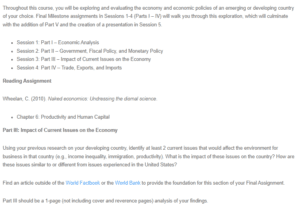China’s Fiscal and Monetary Policy
China has the highest population in the world, which is estimated at 1.4 billion (BBC, 2018). 96.4% of Chinese are literate. Further, the country has made progress in reducing the poverty rate; the country has pulled 68 million of its populace from poverty in half a decade. The country aims at eliminating poverty entirely by 2020 (Brand, 2017). However, various challenges still exist faced by the economy. The Gini coefficient for China, a measure of income dispersion in a population, indicates a steep upward trend over the last decade. Inequality is expected with every kind of industrialization, but in the case of China, the pace has been quite staggering. One of the key drivers of this steep upward trend is the ever-increasing difference in skill premiums and education levels (Chen, 2018). Do you need help with your assignment ? Get in touch with us at eminencepapers.com.
Although the literacy levels in China are at 96.4%, the country is still the most unequal in the world. Trivedi (2019) states that the rapid technological changes in the country result in an increase in demand for skilled workers. Although the number of those graduating from Chinese universities has soared over the last decades, the gap between urban and rural areas tertiary completion and richer and poorer people has increased. For example, in rural Guangxi, approximately 19% of the college population is in tertiary institutions, while 70% of the college population in Shanghai is enrolled in similar educational institutions. These disparities affect business in that populations living in urban areas have a higher likelihood of employment than those in rural areas. Further, the more skilled workforce increases without a corresponding increase in job opportunities, which will result in an influx of highly skilled yet jobless people. The government should look into ways of utilizing the skilled workforce by perhaps introducing fiscal policy incentives that would encourage self-employment.
In the US, the income gap between the top 1% and the remainder continues to grow. In the last half a decade, the national income share of the top 1% has doubled while the poverty rate has inched slightly up and down. 43.5% of Americans are in the low-income bracket or poor (Inequality.Org, 2019). So, like China, the US also faces an ever-growing income gap.
References
BBC (2018) China Country Profile, available at: http://www.bbc.co.uk/news/world-asia-pacific-13017877
Chen, A. (2018) Doing business in China, available at https://uk.practicallaw.thomsonreuters.com/8-501-1377?transitionType=Default&contextData=(sc.Default)&firstPage=true&bhcp=1
Inequality.Org (2019). Income inequality in the United States. https://inequality.org/facts/income-inequality/
Trivedi, A. (2019). China’s Racing to the Top in Income Inequality. https://www.bloomberg.com/opinion/articles/2018-09-23/china-s-racing-to-the-top-in-income-inequality
ORDER A PLAGIARISM-FREE PAPER HERE
We’ll write everything from scratch
Question 
Throughout this course, you will be exploring and evaluating the economy and economic policies of an emerging or developing country of your choice. Final Milestone assignments in Sessions 1-4 (Parts I – IV) will walk you through this exploration, which will culminate with the addition of Part V and the creation of a presentation in Session 5.

China’s Fiscal and Monetary Policy
- Session 1: Part I – Economic Analysis
- Session 2: Part II – Government, Fiscal Policy, and Monetary Policy
- Session 3: Part III – Impact of Current Issues on the Economy
- Session 4: Part IV – Trade, Exports, and Imports
Reading Assignment
Wheelan, C. (2010). Naked economics: Undressing the dismal science.
- Chapter 6: Productivity and Human Capital
Part III: Impact of Current Issues on the Economy
Using your previous research on your developing country, identify at least 2 current issues that would affect the environment for business in that country (e.g., income inequality, immigration, productivity). What is the impact of these issues on the country? How are these issues similar to or different from issues experienced in the United States?
Find an article outside of the World Factbook or the World Bank to provide the foundation for this section of your Final Assignment.
Part III should be a 1-page (not including cover and reverence pages) analysis of your findings.